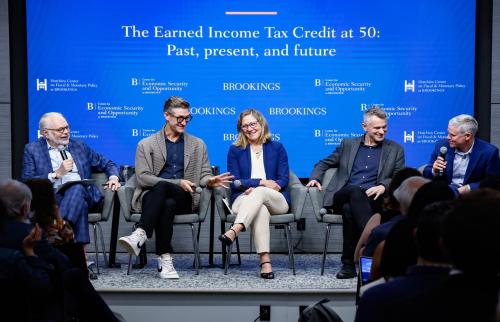Workforce development in the U.S.—which includes various forms of private- and publicly-funded job training and support services for workers—could potentially play a critical role in improving earnings for Americans without bachelor’s degrees and reducing inequality. It can help employers find workers who meet a range of critical skill needs. At its best, it could also help raise both employment and productivity in the U.S. economy. For all these reasons and others, workforce development should be part of any administration’s economic policy playbook, including potential second terms for Donald Trump or Joe Biden.
Our current workforce policies and programs fall well short of achieving their full potential. In addition, the U.S. job market will face some critical new challenges over the next few decades that will require newer and more effective workforce programs plus supportive policies. The most critical challenges include:
- Creating more well-paying jobs and skilled workers to fill them;
- Generating a growing workforce as baby boomers retire; and
- Preparing for the labor market dislocations associated with artificial intelligence (AI).
How will the specific challenges play out in the US labor market?
More good jobs and skilled workers
Too few jobs in the U.S.— especially for workers without college degrees—pay family-sustaining wages and benefits. Employers claim that workers have too few skills to fill better-paying “middle-skill” jobs that don’t require college degrees, in fields like health care, advanced manufacturing, and IT. Indeed, our secondary and post-secondary schools do not generate sufficient numbers of workers to easily fill many occupational categories, especially those requiring technical skills. But employers also choose to create many low-paying, low-skill jobs where they can minimize compensation and training expenses; and, with much lower union membership and weakened regulation, workers lack the bargaining power they once had to force better job creation. In reality, the U.S. needs both better-skilled workers and better-paying jobs for them to fill.
Growing the workforce as baby boomers retire
Separate from the quality of jobs and workers, the numbers and rates of labor force participation in the U.S. have been declining, making it harder for employers to fill vacant jobs. The ongoing retirements of baby boomers has also contributed to declining labor force participation and high job vacancy rates across the U.S. economy, and will continue to do so. Low birth rates in the U.S. will exacerbate these problems over the next few decades. Of course, even before baby boomer retirements began, less-educated men had been dropping out of the labor force while women’s participation has been relatively flat for 25 years; the recent retirements and low birth rates only exacerbate those ongoing problems. Less-educated men face declining wage incentives but also various barriers to work, like criminal records and physical disabilities; while women’s struggles to meet their child care needs almost certainly discourages their labor force activity.
Preparing for AI
AI will almost certainly raise labor market productivity and the overall standard of living in the U.S. But its implementation throughout our economy might also raise the rate of worker dislocation and displacement. When workers are permanently displaced from their jobs, they often suffer long-term wage or employment loss. Such job loss has been large and lasting after the Great Recession. This is especially evident in previously industrialized regions where jobs were eliminated due to digital technology and imports from China; less-educated men and women were broadly hurt by these developments.
We do not yet know the extent to which AI will dislocate workers, nor which workers will face displacement. Historically, new technologies “complement” some workers, raising the demand for their labor, while “substituting” for others, who are broadly hurt. Some early indications suggest that less-educated workers might actually benefit from these new technologies, enabling them to be hired into jobs for which they previously were unprepared, while college graduates in professional jobs will be at greater risk. A lot depends on the extent to which employers will seek to retrain their incumbent workers to perform newer tasks, and how workers respond to these new developments by updating their skills or relocating to new regions where demand for them is higher.
How would the candidates address these challenges?
As president, both Donald Trump and Joe Biden enacted policies they claim would address at least some of these worker and labor force needs, in very different ways. Their past policies give us some indication of what we might expect in a second term for each, though new challenges might require each to consider new approaches.
During his term in office, Trump relied mostly on tax cuts and deregulation, as well as restricting imports and immigrants, to generate more and better jobs for U.S. workers. The Tax Cuts and Jobs Act of 2017 (TCJA) likely bolstered consumer and labor demand, leading to at least some rise in employment and labor force participation, and the tight market probably raised wage growth a bit. But more personal tax cuts could be inflationary and lead to higher interest rates if implemented when the labor market remains tight. Cuts in corporate taxes could also produce more investments and higher worker wages in theory, though the TCJA does not seem to have done so.
Trump’s deregulatory efforts also could, at least in theory, lower employer costs and raise employment, though his ability to eliminate regulations was more limited than he had hoped. A second Trump term would produce more deregulatory efforts, while promoting virtually no new regulation (or federal spending) on job training, labor standards, child care or AI.
The administration’s approach to the global economy can also have consequences for employment. Trump’s first-term tariffs on foreign goods and even inputs (like aluminum and steel) do not seem to have raised domestic employment. Immigration declines during his term, and especially during the pandemic, might have modestly raised domestic employment. But declining immigration also contributed to the problem of a smaller labor force and “missing workers” in 2021-22, while the recovery of immigration since then has helped maintain labor force growth. Trump promises much more severe immigration actions in a second term, especially towards the undocumented. Such actions could potentially generate more jobs and increase wages a bit for native-born workers, though mostly in industries (nondurable manufacturing, residential construction, household services) that require relatively few skills and pay low wages, while the labor force would shrink.
Finally, his efforts to raise skills among U.S. workers focused primarily on bolstering for-profit occupational programs and encouraging industry-recognized apprenticeships outside of the Labor Department’s registration process. These changes were not in place for long enough for us to judge their efficacy, though reducing the burdens of registration on employers is a worthy goal. In Department of Labor training programs, the Trump administration relied primarily on encouraging streamlining and targeting of existing programs. We would likely see more such efforts in a second Trump administration.
In contrast, the Biden administration has approached workforce policy by generating new investments worth hundreds of billions of dollars in job creation and training, while supporting stronger labor standards and union representation to raise worker pay. The new jobs and investments in skill-building are primarily driven by his 2021 relief bill (the American Rescue Plan Act, or ARPA) and three bills to spur American industry: the Inflation Reduction Act (IRA) to promote sustainable energy; the Bipartisan Infrastructure Bill (BIL) to promote transportation and universal access to broadband; and the CHIPS and Science Act to promote U.S. production of semiconductors and other advanced technology products.
The three bills constitute a new form of U.S. “industrial policy,” with investments in key industries, often targeted to regions that have stagnated economically in recent decades. There is a strong preference for unionized workers or labor standards written into these laws. And all three bills create new jobs for highly-skilled workers, both with and without BA degrees. Funds in all three bills will therefore be used for workforce development, and efforts are underway to develop training programs with these funds in all three cases.
The extent to which these efforts will be successful, in terms of cost-effectively meeting their respective goals and creating new jobs filled with skilled workers, will not be known for a number of years. A second term for Biden would allow his administration to further implement these plans, and their effects on workers could then be measured over time.
Furthermore, Biden has recently implemented new regulations on child care affordability and apprenticeship—which should raise parental employment and worker skills respectively as long as any new regulations to ensure quality don’t raise costs and impede their implementation.
The Biden administration initially liberalized immigration enforcement, which successfully bolstered the size of the labor force as we recovered from the pandemic. But political pressures in response to the huge flows of Central and South Americans at our southern border seeking asylum have forced the administration to move to a more restrictive policy stance. New legislation could, in theory, provide needed worker flows into employment while tightening border security, though the odds of any new legislation on this politically charged issue seem remote.
Finally, the Biden administration has begun a process of considering new regulation of AI, to prevent abuses while hopefully not impeding its development and use by industry. It is far too early to ascertain whether those actions will be successful, and new efforts to limit worker displacement still need to be developed.
In sum, a second term for Trump would likely emphasize tax cuts and deregulation, along with restrictions on trade and immigration, to spur more and better job-creation. A second Biden term would allow more time to implement his place-based “industrial policy” and especially its skill-building components. The two candidates and campaigns thus offer stark differences in how the labor market challenges of the next few decades will be addressed.
-
Acknowledgements and disclosures
The Brookings Institution is financed through the support of a diverse array of foundations, corporations, governments, individuals, as well as an endowment. A list of donors can be found in our annual reports published online here. The findings, interpretations, and conclusions in this report are solely those of its author(s) and are not influenced by any donation.
The Brookings Institution is committed to quality, independence, and impact.
We are supported by a diverse array of funders. In line with our values and policies, each Brookings publication represents the sole views of its author(s).







Commentary
3 critical workforce challenges: How would the presidential candidates address them?
April 16, 2024